
USS Suisun (AVP-53) was a United States Navy Barnegat-class small seaplane tender in commission from 1944 to 1955. It was named for northern California's Suisun Bay, which takes its name from the Native American Suisun tribe.

USS Terror (CM-5) was a fleet minelayer of the United States Navy, the only minelayer of the fleet built specifically for and retained for minelaying during World War II.
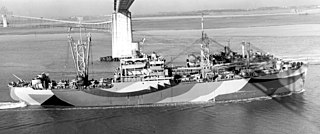
USS Tate (AKA-70) was a Tolland-class attack cargo ship in service with the United States Navy from 1944 to 1946. She was sold into commercial service and was scrapped in 1970.
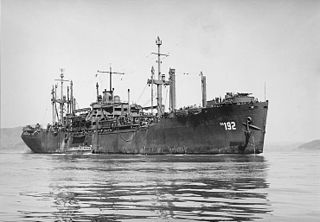
USS Rutland (APA-192) was a Haskell-class attack transport built and used by the US Navy in World War II. She was a Victory ship design, VC2-S-AP5. She was named after Rutland County, Vermont, USA.
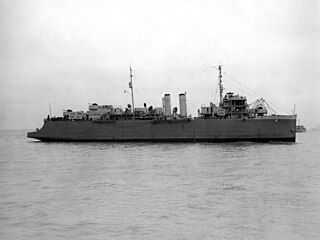
USS Weehawken (CM-12) was originally SS Estrada Palma – a car ferry built in 1920 by William Cramp & Sons of Philadelphia. It was acquired by the United States Navy on 15 June 1942; renamed Weehawken on 18 July 1942; converted to a minelayer by the Bethlehem Steel Co. at Hoboken, New Jersey; designated CM-12; and commissioned on 30 September 1942.
USS Zaurak (AK-117) was a Crater-class cargo ship commissioned by the U.S. Navy for service in World War II. She was responsible for delivering troops, goods and equipment to locations in the war zone.

USS Matar (AK-119) was a Crater-class cargo ship, converted from a Liberty Ship, commissioned by the US Navy for service in World War II. She was first named after Napoleon B. Broward, an American river pilot, captain, and politician; he was elected as the 19th Governor of the US state of Florida. She was renamed and commissioned after Matar, a binary star in the constellation of Pegasus. She was responsible for delivering troops, goods and equipment to locations in the war zone.

USS Azimech (AK-124) was a Crater-class cargo ship commissioned by the US Navy for service in World War II, named after the Azimech, the other name of Spica, the brightest star in constellation Virgo. She was responsible for delivering troops, goods and equipment to locations in the war zone.

USS Ascella (AK-137) was a Crater-class cargo ship commissioned by the US Navy for service in World War II. Ascella was named after Ascella, a star in the constellation Sagittarius. She was responsible for delivering troops, goods and equipment to locations in the Asiatic-Pacific Theater.

USS Kochab (AKS-6) was an Acubens-class general stores issue ship commissioned by the U.S. Navy for service in World War II. She was responsible for delivering and disbursing goods and equipment to locations in the war zone. The vessel was constructed by Delta Shipbuilding Co. of New Orleans, Louisiana and launched on 8 March 1944 under a Maritime Commission contract. After being acquired the U.S. Navy, the vessel was converted into a general stores ship and entered service on 4 November 1944. Kochab supported American operations in the Pacific Theater, sailing between US bases on Pacific islands. Following the war's end, Kochab sailed to the US with returning personnel and operated along the United States West Coast before being decommissioned on 17 April 1946. The vessel was then placed in reserve. Kochab was sold for scrap in 1965.

USS Adria (AF-30) was an Adria-class stores ship in service with the United States Navy from 1944 to 1954. She was scrapped in 1977.

USS Kerstin (AF-34) was an Adria class stores ship in service with the United States Navy from 1945 to 1950.
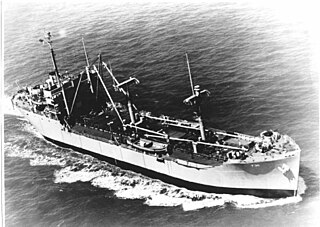
USS Lioba (AF-36) was an Adria-class stores ship in service with the United States Navy from 1945 to 1955. She was scrapped in 1973.
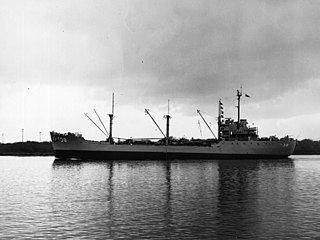
USS Merapi (AF-38) was an Adria stores ship acquired by the U.S. Navy for service in World War II, named after Mount Merapi, the mountain in Java, Indonesia. Her task was to carry stores, refrigerated items, and equipment to ships in the fleet, and to remote stations and staging areas.

USS Athanasia (AF-41) was an Adria-class stores ship in service with the United States Navy in 1945. She was sold into commercial service in 1977.

USS Gosper (APA-170) was a Haskell-class attack transport in service with the United States Navy from 1944 to 1946. She was scrapped in 1974.

USS White Marsh (LSD-8) was an Ashland-class dock landing ship of the United States Navy, named in honor of White Marsh, Virginia, the birthplace of Dr. Walter Reed (1851–1902).

USS Mayfield Victory (AK-232) was a Boulder Victory-class cargo ship acquired by the U.S. Navy during World War II. She served in the Pacific Ocean theatre of operations through the end of the war and then returned to the United States for disposal.
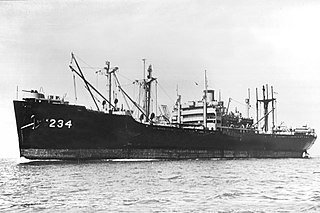
USS Bucyrus Victory (AK-234) was a Boulder Victory-class cargo ship acquired by the U.S. Navy during World War II. She served in the Pacific Ocean theatre of operations through the end of the war, earning one battle star, and then returned to the United States for disposal.

USS Lakewood Victory (AK-236) was a Boulder Victory-class cargo ship acquired by the U.S. Navy during World War II. She served in the Pacific Ocean theatre of operations through the end of the war, earning two battle stars, and then returned to the United States for disposal.



















